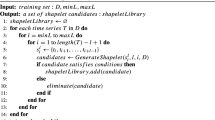Abstract
The two objectives of early classification, accuracy and earliness, contradict with each other. In order to solve the problems of poor interpretation, huge candidate set of shapelets and adjustable quantification between the two objectives, a novel method of early classification of time series based on trend segmentation and optimization of cost function is proposed. Latent information of time series is mined by trend segmentation, and time stamp of discriminative shapelets is extracted. The number of shapelet candidates is greatly reduced by pruning based on the length and location, which improved the discrimination capability of chosen shapelets. An adjustable objective function is also defined to make a trade-off between accuracy and earliness, and then realize the early classification of time series. In view of the earliness and accuracy problems of different tendencies, this paper defines different coefficients to adjust the optimization objective function. The experimental results on UCR repository show that our proposed method achieves competitive results both at earliness and accuracy.









Similar content being viewed by others
References
Aburomman AA, Reaz MBI (2017) A survey of intrusion detection systems based on ensemble and hybrid classifiers. Comput Secur 65:135–152
Ghalwash MF, Radosavljevic V, Obradovic Z (2014) Utilizing temporal patterns for estimating uncertainty in interpretable early decision making. In: Proceedings of the 20th ACM SIGKDD international conference on Knowledge discovery and data mining, pp 402–411
Ghalwash MF, Ramljak D, Obradović Z (2012) Early classification of multivariate time series using a hybrid hmm/svm model. In: 2012 IEEE International conference on bioinformatics and biomedicine. IEEE, pp 1–6
Grabocka J, Schilling N, Wistuba M, Schmidt-Thieme L (2014) Learning time-series shapelets. In: Proceedings of the 20th ACM SIGKDD international conference on Knowledge discovery and data mining, pp 392–401
Haishuai W, Qin Z, Jia W, Shirui P, Yixin C (2019) Time series feature learning with labeled and unlabeled data - sciencedirect. Pattern Recognit 89:55–66
Hatami N, Chira C (2013) Classifiers with a reject option for early time-series classification. In: 2013 IEEE Symposium on computational intelligence and ensemble learning (CIEL). IEEE, pp 9–16
He G, Duan Y, Peng R, Jing X, Qian T, Wang L (2015) Early classification on multivariate time series. Neurocomputing 149:777–787
He G, Zhao W, Xia X (2019) Confidence-based early classification of multivariate time series with multiple interpretable rules. Pattern Anal Applic 1–14
Karevan Z, Suykens J (2020) Transductive lstm for time-series prediction: an application to weather forecasting. Neural Netw 125:1–9
Kim Y, Sa J, Kim S, Lee S (2018) Shapelets-based intrusion detection for protection traffic flooding attacks. In: International conference on database systems for advanced applications. Springer, pp 227–238
Majumdar S, Laha AK (2020) Clustering and classification of time series using topological data analysis with applications to finance. Expert Syst Appl 162:113868
Mori U, Mendiburu A, Keogh E, Lozano JA (2017) Reliable early classification of time series based on discriminating the classes over time. Data Min Knowl Discov 31(1):233–263
Mori U, Mendiburu A, Miranda IM, Lozano JA (2019) Early classification of time series using multi-objective optimization techniques. Inf Sci 492:204–218
Parrish N, Anderson HS, Gupta MR, Hsiao DY (2013) Classifying with confidence from incomplete information. J Machine Learn Res 14(1):3561–3589
Pathak S, Cai X, Rajasekaran S (2018) Ensemble deep timenet: An ensemble learning approach with deep neural networks for time series. In: 2018 IEEE 8Th international conference on computational advances in bio and medical sciences (ICCABS), pp 1–1. https://doi.org/10.1109/ICCABS.2018.8541985
da Silveira TL, Kozakevicius AJ, Rodrigues CR (2017) Single-channel eeg sleep stage classification based on a streamlined set of statistical features in wavelet domain. Med Biol Eng Comput 55(2):343–352
Wang Y, Emonet R, Fromont E, Malinowski S, Menager E, Mosser L, Tavenard R (2019) Learning interpretable shapelets for time series classification through adversarial regularization. arXiv:1906.00917
Xing Z, Pei J, Philip SY (2012) Early classification on time series. Knowl Inform Syst 31 (1):105–127
Xing Z, Pei J, Yu PS, Wang K (2011) Extracting interpretable features for early classification on time series. In: Proceedings of the 2011 SIAM international conference on data mining. SIAM, pp 247–258
Yamaguchi A, Nishikawa T (2018) One-class learning time-series shapelets. In: 2018 IEEE International conference on big data (big data). IEEE, pp 2365–2372
Yan W, Li G, Wu Z, Wang S, Yu PS (2020) Extracting diverse-shapelets for early classification on time series. World Wide Web-Internet And Web Information Systems
Yeh CCM, Zhu Y, Ulanova L, Begum N, Ding Y, Dau HA, Zimmerman Z, Silva DF, Mueen A, Keogh E (2018) Time series joins, motifs, discords and shapelets: a unifying view that exploits the matrix profile. Data Min Knowl Disc 32(1):83–123
Acknowledgements
This work is supported by the Fundamental Research Funds for the Central Universities, China under Grant 2021III030JC.
Author information
Authors and Affiliations
Corresponding author
Ethics declarations
Conflict of Interests
The authors declare that they have no conflict of interest.
Additional information
Publisher’s note
Springer Nature remains neutral with regard to jurisdictional claims in published maps and institutional affiliations.
Rights and permissions
About this article
Cite this article
Zhang, W., Wan, Y. Early classification of time series based on trend segmentation and optimization cost function. Appl Intell 52, 6782–6793 (2022). https://doi.org/10.1007/s10489-021-02788-3
Accepted:
Published:
Issue Date:
DOI: https://doi.org/10.1007/s10489-021-02788-3




